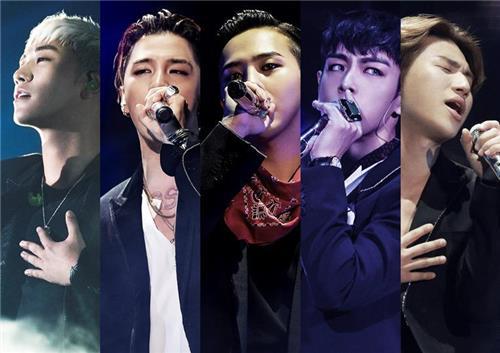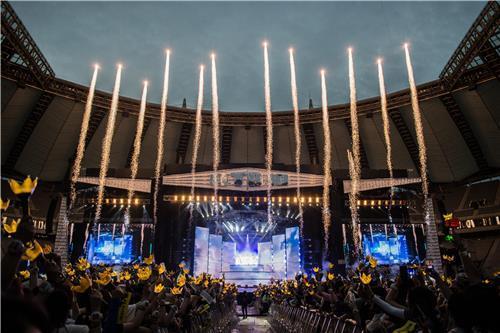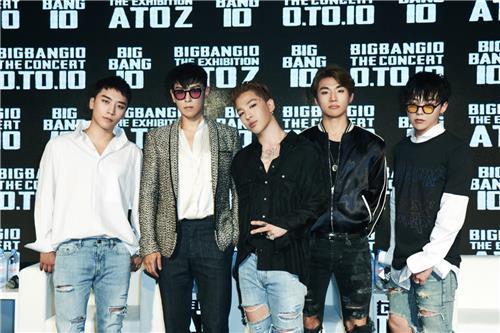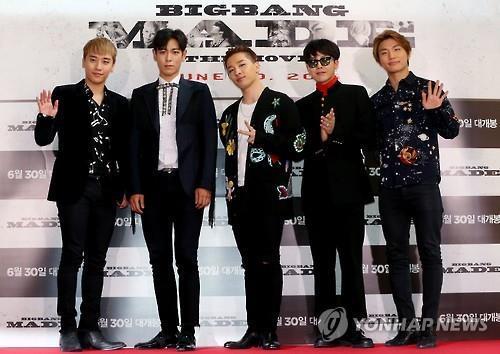- California Assembly OKs highest minimum wage in nation
- S. Korea unveils first graphic cigarette warnings
- US joins with South Korea, Japan in bid to deter North Korea
- LPGA golfer Chun In-gee finally back in action
- S. Korea won’t be top seed in final World Cup qualification round
- US men’s soccer misses 2nd straight Olympics
- US back on track in qualifying with 4-0 win over Guatemala
- High-intensity workout injuries spawn cottage industry
- CDC expands range of Zika mosquitoes into parts of Northeast
- Who knew? ‘The Walking Dead’ is helping families connect
BigBang making highest waves of global K-pop
SEOUL, Aug. 22 (Yonhap) — Few critics deny BigBang’s contribution to pushing K-pop’s global presence to the next level. Celebrating its 10th anniversary this year, the award-winning K-pop quintet not only topped the home market with its dominating style of music, but also spread K-pop as a cultural brand spanning the U.S., Europe, Latin America and the Middle East.
Last year, the K-pop group took home US$44 million in pretax earnings, by far surpassing the $33.5 million earned by Maroon 5, the highest-paid American all-male arena pop group, according to the Forbes Celebrity 100 list — striking richer gains than artist-entrepreneurs Dr. Dre and Jimmy Buffett, who made $41 million and $40.5 million, respectively.

From L: BigBang members Seungri, Taeyang, G-Dragon, T.O.P and Daesung appear in a compiled file image released by the band’s management YG Entertainment on Aug. 20, 2016.
Unlike its present glory, the group started out on tough terrain, with a debut concert in Olympic Stadium in Seoul in 2006. The idol group had strong foes with weapons that BigBang members fell short of.
Super Junior came out in 2005 with catchy dance-pop songs, and FT Island popped up in 2007 with adorable faces and rock ballad hits. The year 2008 gave birth to 2PM, arguably the first brawny idol group with pretty faces, and SHINee, armed with young, sprightly charms.
On the other hand, BigBang started out with hip-hop instilled with R&B-pop, then considered a rarely successful genre for idol groups. The members’ heights and physiques were not particularly impressive either, compared to its rival groups.
After a decade, however, it turned out to be BigBang that proved itself as top Asian artists with a global fandom. With 6 million YouTube subscribers, the K-pop group has raked in a total of 2.8 billion YouTube views altogether.

This photo, released by YG Entertainment, shows BigBang staging a special concert to celebrate its 10th anniversary at Sangam World Cup Stadium in northwestern Seoul on Aug. 20, 2016.
By songs, the YouTube music video of BigBang’s “Fantastic Baby,” released on 2012, drew 24 million views. The other three 100 million breaker hits include “Bang Bang Bang,” “Good Boy” and “Loser.”
By nationality, the largest group of BigBang’s YouTube subscribers are from the U.S., followed by several Southeast Asian countries and Brazil. As of now, BigBang is the only K-pop group that has four music videos with more than 100 million views each on YouTube.
The boy band has swept up “likes” on global social media network Facebook, too. The likes come mostly from Vietnam, the U.S. and Mexico.
The figures mean a lot for Korean entertainment giants that dream of penetrating the U.S. music industry such as YG Entertainment and its two other rivals, S.M. Entertainment and JYP Entertainment. In 2001, Korean singer BoA of S.M. Entertainment was technically the first idol singer to challenge the U.S. music market. Her multilingual assets and powerful dance moves dubbed her one of the most popular singers in Japan, but the rave fell short of securing inroads to the Western market. K-pop girl group Wonder Girls of JYP Entertainment took off for a U.S. debut in 2009, but returned home without tangible gains.
In contrast, BigBang was able to increase its presence in the global music scene in an indirect route — a world tour.
In its first world tour in 2012, BigBang drew 800,000 concert-goers.
The number almost doubled in the second world tour in 2015, in which the band drew 1.5 million. Of the tally, 87,000 were from North American concerts and 250,000 from China concerts — both new records for K-pop musicians.

From L: BigBang members Seungri, T.O.P, Taeyang, Daesung and G-Dragon attend the press conference to celebrate their 10th anniversary in S Factory, eastern Seoul, on Aug. 4, 2016.
At the domestic level, BigBang has shown a successful variation on the then-conventional formula of an idol fostering system.
Its agency, YG Entertainment, had bet big on the band members’ potential and style rather than their appearance. In the early 2000s, idol singers were rarely given the chance to list self-composed or self-produced songs in their own albums.
BigBang members, on the contrary, were armed with song-writing, rapping and fashion styling, on top of the traditional requisites of vocals and dancing abilities.
Their pre-debut marketing turned out successful as well. The agency made a televised reality show — showing then-trainee members competing and struggling to make their debut.
Earlier this month, BigBang vowed to continue their group’s activities for decades to come as they attended a press conference for a celebratory art exhibition. The vow seems plausible, judging from some of the fates of K-pop idol singers. The members have yet another big challenge coming up, as all five are subject to mandatory 2-year military conscription. T.O.P, the eldest member to turn 29 in November, is expected to be the first member to be conscripted, and other members are to soon follow suit.
“I have the conviction and confidence that all five (BigBang members) will stay together throughout (our lives,)” said BigBang’s G-Dragon, during a media event.

Members of South Korean K-pop group BigBang attend the movie premiere event of the band’s autobiographical documentary film “BigBang Made” in western Seoul on June 28, 2016.















